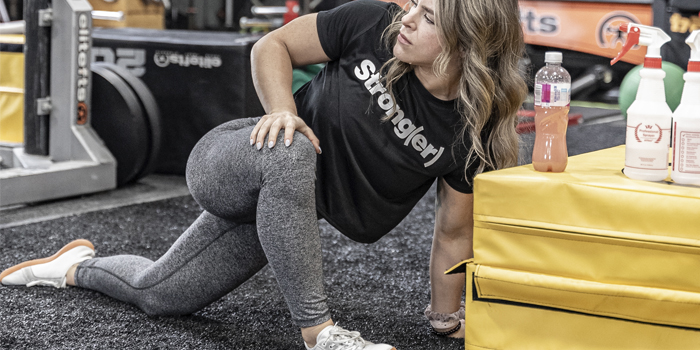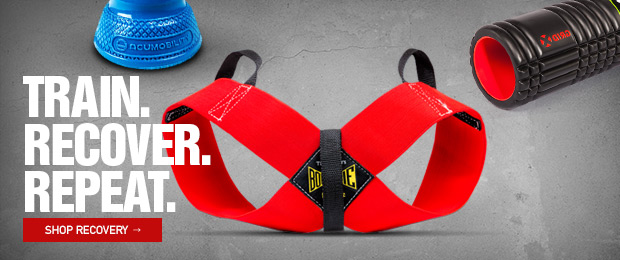
The big lifts are great for developing strength, power, and overall muscle. Push them hard and heavy, and it is easy to see muscle growth and performance improvements. While this is great to build the foundation of a good training program, many trainees and athletes get stuck in the practice of training only bilateral lifts—in one plane of motion. To prevent overuse injuries, deload the low back and pelvis, maintain side-to-side balance and develop adequate stability and control throughout the body—as a powerlifter or an athlete—include the appropriate accessory and recovery work outside of the main lifts.
Here are four hacks to prevent overuse injuries in the back and hips:
1. Include Single-Limb Work
Lunge, Step-Up, Split Squat, Single-Leg Squat, Single-Leg Hip Thrust, and Single-Leg RDL variations are all important to include here for lower-body focused work.
Dumbbell Work, Single-Arm Cable, Band, and Landmine variations are all essential for upper-body work.
Without including these single limb work, side-to-side imbalances are much more likely to occur, and stability and control between the ribs and pelvis and from the head to the foot will not be adequately developed.
RECENT: 6 Exercises to Improve Posture (and Recover)
If muscle development is of concern, single limb work will hit specific stabilizing fibers that are not called upon with bilateral work.
Bottom Line: If you want optimal development and bulletproofing of your body, be sure to include both single and double limb work with your training. Maintaining square and stacked pelvic and rib positioning is especially important while keeping the knee in line with a solid and grounded foot. Someone with a rotation or shift in their pelvis or thorax will need to pay extra attention to this and have a watchful eye since they are more likely to "feel" neutral while they are in their comfortable misalignment.
2. Train in Multiple Planes of Motion
While the sagittal plane is great to develop force output in the pursuit of strength and power, most activities in sport and life occur in three planes of motion.
Even if the main goal is improving power and Olympic lifts, doing accessory work in the frontal (side to side) and transverse planes (rotational) will help hit weak points and keep the body healthy while providing movement balance and overuse prevention.
Offset Carries, Rotational Cable Chops, Lateral Lunges, Rotational Lunges, Rotational Med Ball Tosses, and Landmine Rotation Variations are a few nice examples here.
A couple of favorites that I have used successfully with many clients and myself to address the above, as well as fix and prevent shifts and rotations, include:
Lateral Step-Ups
Lateral lunges are great, but this step-up variation challenges side-to-side single leg and pelvic control to an even greater extent. Controlling the lowering here and maintaining knee, hip, and foot position is essential, as it is easy to just flop over to the side that is stepping down. These are also a great way to train the adductors and abductors in a compound pattern.
Side-to-Side Sandbag Lunges
These are a great way to integrate thoracic rotation abilities and anti-rotational control into an alternating single-leg squat pattern, tying together upper and lower action. They are harder than you might think, so start light.
Half-Kneeling Cable Holds
Developing the ability to CONTROL rotation is important since we can't efficiently produce it when we can't control it. While this exercise is at least somewhat more commonly seen nowadays, it is easy to miss some intricate details:
- Be sure to keep the hips and ribs square and level while pulling far enough into the hip of the forward leg. Without doing this, one side of the pelvis will be shooting forward too much, and you'll end up training stabilization in a faulty position. See the next section to learn more about "pulling into" the hip.
- Be sure to keep the down hip and thigh straight while engaging the glute and avoid sagging into that side of the pelvis, going into adduction (which will happen if that glute medius is not doing its job of stabilizing the pelvis).
- Be sure to REACH fully, protracting both scapulae. This helps drive abdominal activation and solidifies a better rib and thoracic position. Add in a full inhale and exhale to really drive home your rotational stabilization in this position.
You can add in a breath while your arms are out to make these more challenging and develop solid stability.
Deadlift Cable Holds
Train the entire lateral side of your torso and hips to stabilize in a deadlift-specific position with this gem. They can be done for static holds or with arm chops, keeping the torso stable. Brace hard and get grounded with the floor.
3. Provide Some Alternation and Stability for the Low Back and Sacroiliac Region
Many sagittal plane exercises like squats, deadlifts, presses, etc., lock us into an extended, static position. Without any balance to all of this and without specifically training alternation between each side of our pelvis and rib cage, we can easily lose the ability to effectively get into and out of each hip. Our low back and SI region can get jammed up, causing all kinds of fun issues. Here are a couple of exercises to help give us some love in this department.
Adductor Pullbacks
Adductors are an overlooked muscle group to train in general. This exercise and its progressions train the adductors in a way that many adductor exercises do not.
Most common adductor exercises are training the femur (thigh bone) moving in the acetabulum (hip joint). Adductor Pullbacks train the acetabulum to move over the femur before moving the femur in the acetabulum—how the hips work when we do full-body movement on our feet. We will be laying on our right side and training the left adductor for this example. Lay on your side with your pelvis and ribs lined up. Be sure that your low back is not extended. Place a pad between your thighs. Inhale as your pull your top knee behind your bottom knee, then exhale as you push the top knee down into the pad. Pull back farther and squeeze down again for the next two breaths. Once you can no longer pull back any farther, reset, and start over.
Note: Your back and hips should remain square when you pull back. It is a "scissoring" motion, not a "rolling back" of the hips. Eventually, you can progress to variations performed in different postural positions, such as seated and up on your feet, standing, or squatting. The motion stays the same while the postural position progresses.
We are essentially pulling ourselves into mid stance when we do this. It's a great exercise to use as a warm-up and an accessory for someone with a significant hip shift that might show up when squatting, walking, standing, etc.
A right shift tends to be very common based on the asymmetrical anatomy that we are designed with as humans. In this case, pulling to the left would be the priority. Whether focusing on one side or alternating sides, this is also a great exercise and movement to help "unjam" the back of the pelvis and low back from all of the loaded extension biased and sagittal work done. In a nutshell, it helps to give those structures on the backside some room to breathe and provides a sigh of relief, releasing the" vice" that has been wrenching back there.
Pullback with Internal Rotation
Adding in hip rotation is also an option, depending on what is needed.
Internally rotating the hip once the pullback is accomplished is a great way to strengthen the anterior glute medius (the forgotten part of the glute family towards the front side of the hip) and build better-hinging abilities when needed. If you don't have enough available internal rotation, compensation in the low back or knees usually occurs as you descend into a squat or hinge.
Developing more with an exercise like this can do a lot to help improve this area. Here is a seated variation. The standard pullback can also be progressed and performed in this position.
Standing Scissor Shift
While the previous two movements are great for getting the adductors and anterior glute med starting the party, we also have to train the contralateral glute and adductor on either side. Training the contralateral glute and adductor on either side to work together to drive hip alternation and pelvic position is ultimately essential to stabilizing and controlling the pelvis.
We are using the glute on the planted leg to help push to the opposite side of the pelvis while the adductor muscles on the opposite side pull it over there. We have the added benefit of tying this in with foot stability all of the way through the floor, which needs to be trained to put those last few concepts into action while up on our feet.
All of these exercise variations can either be performed for reps, with active motion each rep, or statically, pulling into position and breathing for 3-4 sets of 8-12 reps or 4-6 breaths.
4. Stay on Top of Soft Tissue Work
Keeping your tissue healthy is beyond important if you want to keep moving well, minimize pain, and maximize performance. I became a manual therapist over a decade ago because I realized this reality. While there is debate over what is going on with interventions in this department (most arrows point to a large number of neural effects), it is beyond obvious that some good things happen with both symptom relief and movement quality. While having a professional work on you is ideal from time to time, there are plenty of self-massage tools out there these days.
I think many of you reading this are at least somewhat familiar with the option of using a foam roller or lacrosse ball on your back and hips, sitting in a massage chair, etc., so I'm not going to spend time covering the obvious. What I am going to do is share a less seen self-release method.
A common hidden culprit of both low back and hip issues is the psoas and its partner, the iliacus (which I covered a bit in my hip flexor article). Since the psoas attaches to both the hip and the lumbar spine in the low back, it can exert its pull on either end. When this muscle is angry and lit up, you will know it.
If you've ever felt that burning pain deep through your hip and into your low back after you've been sitting for a couple of hours on that road trip or on that kayaking expedition, this is likely the perpetrator.
When the psoas and/or iliacus are angry, they will make it a hell of a lot more difficult to extend your hips than it should be. While there are some professionals that might whine and cry about telling someone to push in this area, if you do it correctly and gently, it can really make a difference with low back and hip symptoms as well as hip movement when restrictive.
If this happens often, the appropriate exercises need to be done to help fix whatever imbalance or dysfunction is going on; however, this can sure make things feel better in the meantime.

Nick Rosencutter is the founder and owner of Rosencutter Ultra Fitness & Performance in Greenfield, WI. Nick is a Certified Strength and Conditioning Specialist and Certified Personal Trainer through the National Strength and Conditioning Association. He is also a Licensed Massage Therapist and Full Body Level 2 Active Release Techniques provider with Elite Provider designation. Nick heads up strength and conditioning at Greendale High School and regularly trains and consults with youth to elite-level Olympic speed skaters.









